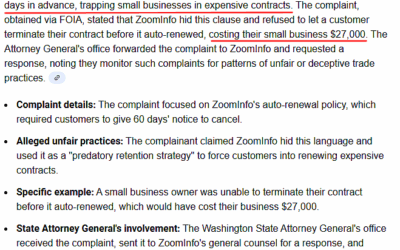What in the World Is a Go-To-Market Strategy? (And Why ZoomInfo Is Butchering the Term)
Introduction: What Is a GTM Strategy?
If you’ve ever Googled “What is a GTM strategy?”, you’ve likely been hit with a barrage of vague definitions, corporate buzzwords, and sales platforms claiming to be the answer to all your problems. But here’s the truth: Go-To-Market (GTM) strategy is not a SaaS feature or a magic dashboard. It’s a core business framework that, when done right, can mean the difference between a successful product launch and a total flop.
In this post, we’ll break down what a GTM strategy really is, how to build one, and why ZoomInfo—yes, that ZoomInfo—is doing the business world a disservice by hijacking and diluting the term.
What Is a GTM Strategy?
A Go-To-Market (GTM) strategy is a tactical action plan that outlines how a company will sell its products or services to customers. It involves aligning your sales, marketing, product, and customer support teams to ensure a successful product launch or market entry.
A typical GTM strategy answers these questions:
-
Who is the target customer?
-
What value are we offering them?
-
Where will we find them (channels)?
-
How will we reach and convert them?
-
Why should they choose us over competitors?
In other words, a GTM strategy is how you bring your value to market efficiently and profitably. It’s the roadmap that keeps your business from wandering into the void of failed launches, poor sales, and misaligned teams.
ZoomInfo’s Obsession with “Go-To-Market”
Now that you understand what a GTM strategy is, let’s talk about ZoomInfo—a company that has turned “GTM” into their marketing North Star, and arguably, their entire personality.
Originally known for selling contact data and intelligence tools, ZoomInfo rebranded itself as the all-in-one Go-To-Market platform. They’ve plastered GTM on every product, press release, and tagline imaginable. In a move that would make even the boldest marketer cringe, they even changed their stock ticker from ZI to GTM.
Yes, seriously.
The Problem with ZoomInfo’s “GTM Everything” Strategy
ZoomInfo’s approach to branding everything as “Go-To-Market” is not just a little over-the-top—it’s misleading.
Here’s what they’ve done:
-
Rebranded their data platform as a GTM cloud.
-
Marketed their sales tools as GTM intelligence.
-
Replaced meaningful strategy with jargon-speak like “GTM orchestration” and “GTM activation.”
This might sound like innovation, but what they’re really doing is stripping meaning from an already misunderstood term. When everything is GTM, nothing is.
And let’s be clear: slapping “GTM” on your tool doesn’t make it a strategy. It makes it a buzzword with a UI.
Why This Hurts Businesses Trying to Build Real GTM Strategies
When companies like ZoomInfo flood the market with empty GTM rhetoric, they create confusion. Founders, marketers, and execs searching “What is a GTM strategy?” end up thinking it’s just another tool or SaaS subscription.
That’s dangerous.
A real GTM strategy requires:
-
Research
-
Cross-functional planning
-
Positioning
-
Messaging
-
Channel strategy
-
Sales enablement
It’s not something you plug in and automate. It’s something you build, iterate on, and align your company around.
ZoomInfo, in its race to own the acronym, has turned it into a marketing punchline.
What a Real GTM Strategy Looks Like
If you’re trying to develop a Go-To-Market strategy that actually works, focus on the fundamentals:
1. Identify Your ICP (Ideal Customer Profile)
Who is most likely to buy and benefit from your solution?
2. Craft a Clear Value Proposition
What specific problem do you solve, and why are you better than the alternatives?
3. Choose Your Sales and Marketing Channels
Are you going outbound? Inbound? Product-led? Pick channels where your ICP lives.
4. Build Messaging That Resonates
Speak directly to customer pain points. Don’t “GTM-ify” your messaging into oblivion.
5. Align Your Teams
Make sure your product, marketing, sales, and success teams are all rowing in the same direction.
GTM ≠ SaaS Buzzword
The phrase “Go-To-Market strategy” isn’t new, and it certainly isn’t something ZoomInfo invented. But if you’ve been watching their recent branding spree, you’d think they discovered fire. Instead, they’ve wrapped a useful strategic concept in a thick layer of jargon, AI-fluff, and overpriced dashboards.
Don’t buy into the hype. GTM is a strategy. Not a slogan. Not a ticker symbol. And definitely not something that should be marketed like a miracle supplement.
For more affordable solutions with better data – let’s chat! Companies are switching from Zoominfo to Lead411 every week, and finding more complete and usable data.
Recent Posts
Top 5 B2B Data Providers for Energy / CleanTech Companies in 2026 (Reviewed)
Article Summary Energy and clean technology companies need accurate, industry-specific B2B data to identify active projects and decision-makers. The best B2B data providers offer more than contact lists, including intent signals, growth triggers, and verified...
Top 5 B2B Data Providers for Staffing and Recruiting Companies in 2026 (Reviewed)
Summary: For staffing and recruiting firms, having accurate, up-to-date B2B data is essential. Whether you’re targeting HR directors, hiring managers, or C-suite executives, a high-quality data provider can save hours of research and give you a competitive edge. In...
Why Zoominfo Contracts are Hard to Cancel
Quick Summary ZoomInfo contracts often come with long-term commitments and annual billing. Automatic renewals and strict cancellation policies make terminating services tricky. Unused credits and account manager retention efforts can further complicate cancellation....




